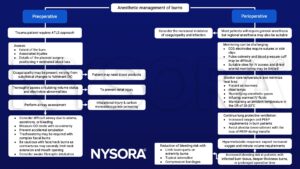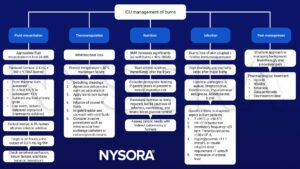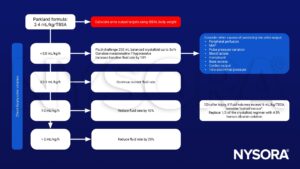Learning objectives
- Describe the main challenges of caring for a patient with major burns
- Explain the ways for optimizing intravenous fluid therapy to avoid under- and over-resuscitation
- Anesthetic management of patients with burns
Definition and mechanisms
- A burn is an injury to the skin or other organic tissue primarily caused by heat, cold, radiation, radioactivity, electricity, friction, or contact with chemicals
- Thermoregulation, blood loss, and coagulopathy are key considerations for the anesthetist during surgery for major burns
- Burns around the mouth or singed hair inside the nose may indicate that burns to the airways have occurred
Signs and symptoms
Skin burns:
- Discomfort, pressure, or pain
- Coloring of the skin: red, pink, white or black
- Blisters
Airway burns:
- Shortness of breath
- Hoarseness
- Stridor
- Wheezing
Classification
- First degree: epidermal or superficial burn
- Simple erythema involving damage to the epidermis
- Excluded from the calculation of the surface area involved
- Second degree: partial thickness
- Third degree: full thickness
Systemic effects
| Respiratory effects | Bronchospasm Acute Respiratory Distress Syndrome |
| Cardiovascular effects | Hypovolemia Myocardial depression ↓ Cardiac output Burns shock up to 48h |
| Vascular effects | ↑ Capillary permeability Na+ and proteins leak into interstitium Tissue edema |
| Peripheral and splanchnic vasoconstriction | Acute kidney injury (AKI) Ileus GI stress ulceration |
| Fluid resuscitation | Tissue edema Pulmonary edema Abdominal compartment syndrome |
| Systemic inflammatory respone to injury | HPA axis activation ↑ ADH Sympathetic NS activation ↑ RAAS Hypercoagulability Hypoalbuminemia |
| Hypermetabolic phase from 48h up to 1 year | ↑ Catecholamines, cortisol, glucagon ↓ Insulin ↑ Hepatic gluconeogenesis, glycogenolysis, lipolysis, proteolysis Hyperdynamic circulation Hyperthermia Increased O2 consumption Weight loss Muscle weakness Immunosupression Impaired wound healing |
Complications
- Bacterial infection
- Sepsis
- Hypovolemia
- Hypothermia
- Hypoperfusion
- Airway problems:
- Obstruction of airway
- Infection
- Pneumonia
- Burn shock (deprivation of oxygenated blood to organs)
- Multiorgan failure
- Scars
- Bone and joint problems
- Compartment syndrome
Anesthetic management

ICU management

Parkland formula

Suggested reading
- McCann C, Watson A, Barnes D. Major burns: Part 1. Epidemiology, pathophysiology and initial management. BJA Educ. 2022;22(3):94-103.
- McGovern C, Puxty K, Paton L. Major burns: part 2. Anaesthesia, intensive care and pain management. BJA Educ. 2022;22(4):138-145.
We would love to hear from you. If you should detect any errors, email us customerservice@nysora.com